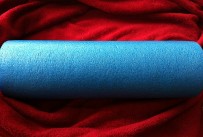The roller is your friend

The roller is your friend
Written by: Paul Kochoa, PT, DPT, OCS, CKTP, CGFI
Stretching is important. I’ve written about it before. The other thing that works really well with stretching is the roller. You’ve probably seen them in gyms, they’re usually black or white and made of foam. Most of the time, people will be contorted in all different positions over the foam roll and rolling up and down over their limbs making grimacing faces. Sometimes it can be painful, it certainly isn’t comfortable.
The foam roll is a great tool to supplement your stretching routine. I’ve used them many times with my patients, and in the long run, they’ve had great results with increased mobility and decreased movement dysfunctions. The one problem I have is that it can be painful, and that really can deter compliance. But if you can tolerate the discomfort, you’ll notice the difference.
Stretching elongates muscles, tendons, and to a smaller degree, ligaments. Other structures that can contribute to tightness are the myofascia, skin, and all the other connective tissues. We’ll call them the ‘soft bits’. Rolling really gets those soft bits moving on each other, and it’s that shearing, transverse movement that can break up any knots or tendon points that can limit mobility.
One type of rolling exercise is rolling the ITB. The ITB is a connective tissue structure on the side of the leg that can get tight, especially with runners. It’s technically a tendon that connects the pelvic bone with the side of the knee and houses the Tensor Facia Lata muscle. Along with the Gluteus Medius muscle, stabilizes the hip in standing, walking, and running.
Rolling the ITB can be painful, especially if it’s tight. Here’s a picture of the set up:
Basically, you’re lying on your side, the roll under the side of your thigh. With your body supported by your arms and the leg, roll the foam up and down the side of your leg, taking care not to roll over any bony parts. Doing this up and down rolling for up to 5 minutes can really loosen up your soft bits and increase the mobility of all the lateral tissue structures that cause hip or knee pain.
But don’t stop there, the leg is surrounded by muscle and soft bits. So the rolling needs to involve those structures too. Try changing the angle but tilting your body forward to get the anterior side of the leg or tilting backward to get the posterior side of the leg. You need to seek out those areas that are tender and painful. Tenderness and pain usually signify a tissue mobility problem, meaning that some of the soft bits are bound down. But remember, pain and discomfort while you’re mobilizing is normal, just as long as you’re feeling alright afterwards. If you have any questions, ask your physiotherapist.
Breaking that up and mobilizing that tissue can be painful, but stick with it. You’ll be rewarded with increased mobility and suppleness.
If you would like more information, please call Professional Physical Therapy and Training at 973-270-7417. Our offices are located within the YMCA locations in Madison and Summit, NJ. You do not need to be a member of the YMCA to visit with us.
Image courtesy of Rachel Kramer Bussel / Flickr.com